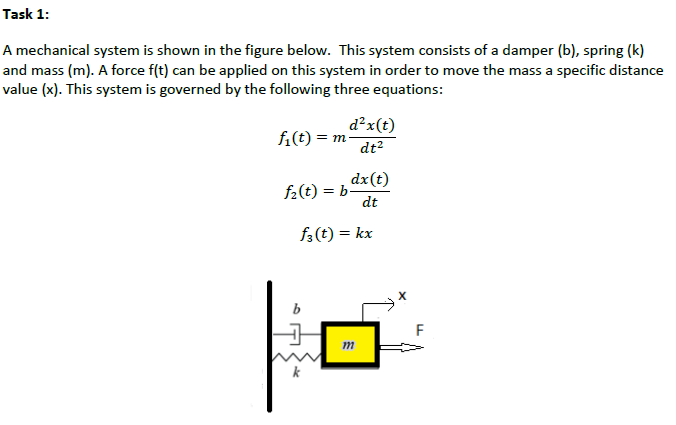Law) i) If m=2, b=1, and k=6, solve this second order differential equation assuming homogeneous case (f(t)=0). ii) If someone applied a force f(t)= 2 N (starting at t=0) to the previous system, solve this nonhomogeneous second order differential equation.
Law) i) If m=2, b=1, and k=6, solve this second order differential equation assuming homogeneous case (f(t)=0). ii) If someone applied a force f(t)= 2 N (starting at t=0) to the previous system, solve this nonhomogeneous second order differential equation.
Elements Of Electromagnetics
7th Edition
ISBN:9780190698614
Author:Sadiku, Matthew N. O.
Publisher:Sadiku, Matthew N. O.
ChapterMA: Math Assessment
Section: Chapter Questions
Problem 1.1MA
Related questions
Question

Transcribed Image Text:Task 1:
A mechanical system is shown in the figure below. This system consists of a damper (b), spring (k)
and mass (m). A force f(t) can be applied on this system in order to move the mass a specific distance
value (x). This system is governed by the following three equations:
d²x(t)
f₁(t) = m
dt²
f₂(t) = b
dx(t)
dt
f3 (t) = kx
b
m
F

Transcribed Image Text:(i)
Formulate a differential equation to express the previous system (apply Newton's Second
Law)
(ii)
If m=2, b=1, and k=6, solve this second order differential equation assuming homogeneous
case (f(t)=0).
(iii)
If someone applied a force f(t)= 2 N (starting at t=0) to the previous system, solve this
nonhomogeneous second order differential equation.
Expert Solution
This question has been solved!
Explore an expertly crafted, step-by-step solution for a thorough understanding of key concepts.
Step by step
Solved in 3 steps with 3 images

Knowledge Booster
Learn more about
Need a deep-dive on the concept behind this application? Look no further. Learn more about this topic, mechanical-engineering and related others by exploring similar questions and additional content below.Recommended textbooks for you

Elements Of Electromagnetics
Mechanical Engineering
ISBN:
9780190698614
Author:
Sadiku, Matthew N. O.
Publisher:
Oxford University Press

Mechanics of Materials (10th Edition)
Mechanical Engineering
ISBN:
9780134319650
Author:
Russell C. Hibbeler
Publisher:
PEARSON

Thermodynamics: An Engineering Approach
Mechanical Engineering
ISBN:
9781259822674
Author:
Yunus A. Cengel Dr., Michael A. Boles
Publisher:
McGraw-Hill Education

Elements Of Electromagnetics
Mechanical Engineering
ISBN:
9780190698614
Author:
Sadiku, Matthew N. O.
Publisher:
Oxford University Press

Mechanics of Materials (10th Edition)
Mechanical Engineering
ISBN:
9780134319650
Author:
Russell C. Hibbeler
Publisher:
PEARSON

Thermodynamics: An Engineering Approach
Mechanical Engineering
ISBN:
9781259822674
Author:
Yunus A. Cengel Dr., Michael A. Boles
Publisher:
McGraw-Hill Education

Control Systems Engineering
Mechanical Engineering
ISBN:
9781118170519
Author:
Norman S. Nise
Publisher:
WILEY

Mechanics of Materials (MindTap Course List)
Mechanical Engineering
ISBN:
9781337093347
Author:
Barry J. Goodno, James M. Gere
Publisher:
Cengage Learning

Engineering Mechanics: Statics
Mechanical Engineering
ISBN:
9781118807330
Author:
James L. Meriam, L. G. Kraige, J. N. Bolton
Publisher:
WILEY